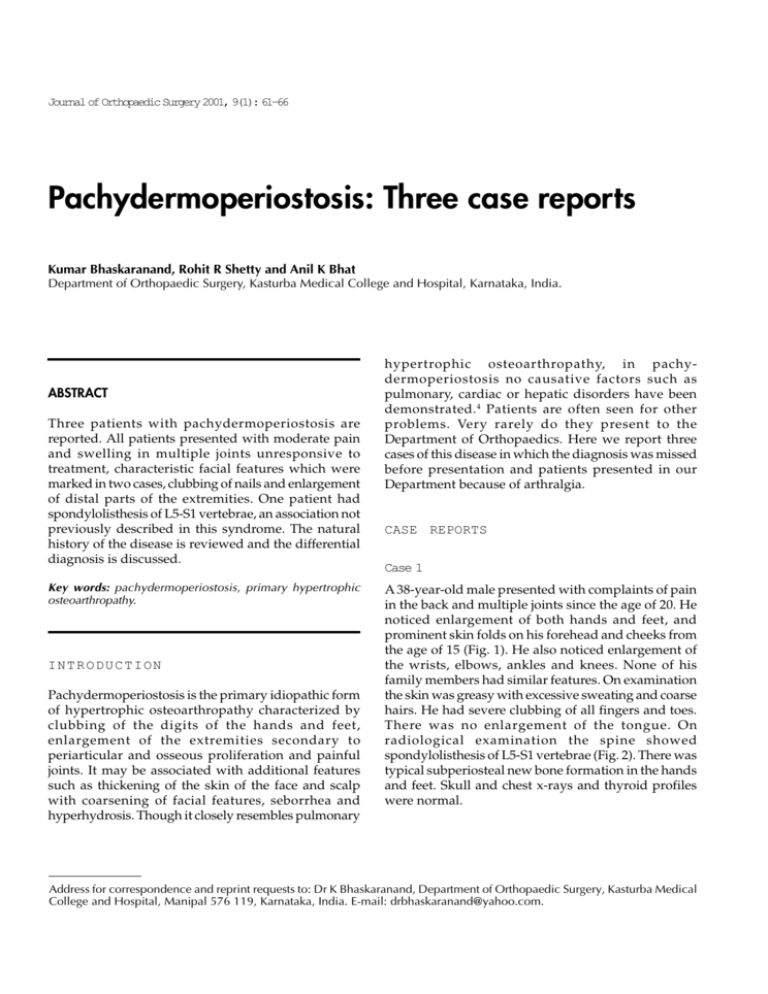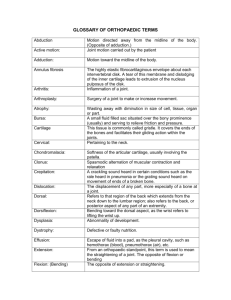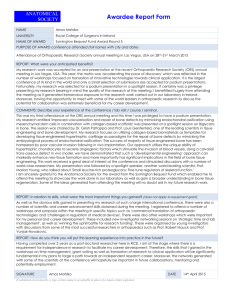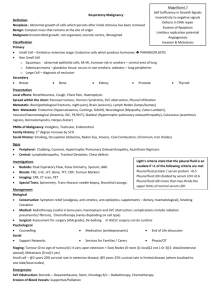Pachydermoperiostosis: Three case reports
advertisement

Journal of Orthopaedic Surgery 2001, 9(1): 61–66 Pachydermoperiostosis: Three case reports Kumar Bhaskaranand, Rohit R Shetty and Anil K Bhat Department of Orthopaedic Surgery, Kasturba Medical College and Hospital, Karnataka, India. ABSTRACT Three patients with pachydermoperiostosis are reported. All patients presented with moderate pain and swelling in multiple joints unresponsive to treatment, characteristic facial features which were marked in two cases, clubbing of nails and enlargement of distal parts of the extremities. One patient had spondylolisthesis of L5-S1 vertebrae, an association not previously described in this syndrome. The natural history of the disease is reviewed and the differential diagnosis is discussed. Key words: pachydermoperiostosis, primary hypertrophic osteoarthropathy. INTRODUCTION Pachydermoperiostosis is the primary idiopathic form of hypertrophic osteoarthropathy characterized by clubbing of the digits of the hands and feet, enlargement of the extremities secondary to periarticular and osseous proliferation and painful joints. It may be associated with additional features such as thickening of the skin of the face and scalp with coarsening of facial features, seborrhea and hyperhydrosis. Though it closely resembles pulmonary hypertrophic osteoarthropathy, in pachydermoperiostosis no causative factors such as pulmonary, cardiac or hepatic disorders have been demonstrated. 4 Patients are often seen for other problems. Very rarely do they present to the Department of Orthopaedics. Here we report three cases of this disease in which the diagnosis was missed before presentation and patients presented in our Department because of arthralgia. CASE REPORTS Case 1 A 38-year-old male presented with complaints of pain in the back and multiple joints since the age of 20. He noticed enlargement of both hands and feet, and prominent skin folds on his forehead and cheeks from the age of 15 (Fig. 1). He also noticed enlargement of the wrists, elbows, ankles and knees. None of his family members had similar features. On examination the skin was greasy with excessive sweating and coarse hairs. He had severe clubbing of all fingers and toes. There was no enlargement of the tongue. On radiological examination the spine showed spondylolisthesis of L5-S1 vertebrae (Fig. 2). There was typical subperiosteal new bone formation in the hands and feet. Skull and chest x-rays and thyroid profiles were normal. Address for correspondence and reprint requests to: Dr K Bhaskaranand, Department of Orthopaedic Surgery, Kasturba Medical College and Hospital, Manipal 576 119, Karnataka, India. E-mail: drbhaskaranand@yahoo.com. 62 Kumar Bhaskaranand et al. Figure 1 Facial features of a Pachydermoperiostosis patient. Case 2 A 56-year-old male presented with complaints of pain in the neck and multiple joints since the age of 16. He had noticed enlargement of both the hands and feet since then (Fig. 3). On examination he had thickening of the skin of his hands and feet, whereas the skin of Journal of Orthopaedic Surgery Figure 2 X-Ray of Lumbosacral spine (lateral view) showing L5-S1 Spondylolisthesis. the forehead and cheeks was only mildly involved. He had severe clubbing of all toes and fingers. There was no enlargement of the tongue. X-rays showed subperiosteal new bone formation in the hands and feet (Fig. 4 and Fig. 5). Skull and chest x-rays were normal. Figure 3 Clinical photograph showing enlarged hands and feet. Vol. 9 No. 1, June 2001 Pachydermoperiostosis: Three case reports Figure 4 X-Ray of both hands showing subperiosteal new bone formation. Figure 5 X-Ray of feet showing subperiosteal new bone formation. 63 64 Kumar Bhaskaranand et al. Case 3 A 30-year-old male presented with pain in multiple joints since the age of 15. He also noticed enlargement of his hands, wrists, feet and ankles. He had excessive sweating in both hands for the last 10 years. On examination he had severe clubbing, and thickened Journal of Orthopaedic Surgery and prominent skin folds of the forehead, cheeks and nasolabial fold. He had generalized ligamentous laxity. There was no enlargement of the tongue. X-rays showed subperiosteal new bone formation in the distal third of the radius, ulna, tibia, fibula, metacarpals, metatarsals and phalanges bilaterally (Fig. 6 and Fig. 7). Skull and chest x-rays were normal. Figure 6 X-Ray of radius and ulna showing subperiosteal new bone formation. Figure 7 X-Ray of tibia and fibula showing subperiosteal new bone formation. Vol. 9 No. 1, June 2001 DISCUSSION Since the description in 1868 by Friedrich of pachydermoperiostosis in two young brothers, the disease has been better understood but is still uncommon. 5 In 1907, Unna described marked thickening of the skin of the forehead and its resemblance to the sulci and gyri of the brain and called it ‘cutis vertices gyrata’.9 The association of cutis verticis gyrata and pachydermoperiostosis is sometimes referred to as Tourane-Solente-Gole syndrome.4 The disorder is inherited as an autosomal dominant trait with variable expression. One-third of these patients have a positive family history3 but in none of our patients was this condition familial. Hypertrophic osteoarthropathy in childhood is an infrequent occurrence. When present, the abnormality has been said to be associated with congenital heart disease, bronchiectasis, pneumonia and cystic fibrosis. The association of hypertrophic osteoarthropathy in childhood malignancy is rare and has been reported only in a few cases of Hodgkin’s disease8. As seen by Ameri et al. it may occur with undifferentiated Pachydermoperiostosis: Three case reports 65 epithelial cell carcinoma of the nasopharynx with metastasis to the lung and the neck. 1 Hence, malignancy should be included in the differential diagnosis of hypertrophic osteoarthropathy in childhood as all our patients had the onset of symptoms between the ages of 15 and 16 years. The clinical manifestations of pachydermoperiostosis are somewhat variable with respect to skin and bone changes. The various clinical expressions include the complete form (pachydermia, periostitis, cutis verticis gyrata), the incomplete form (absence of cutis verticis gyrata) and forme fruste (pachydermia with minimal or absent periostitis).7,10 Cases 1 and 3 had gross thickening of the skin over the face, forehead and scalp, which are classically described in pachydermoperiostosis. However, Case 2 had minimal changes. All cases had severe clubbing of digits of fingers and toes. Radiologically all of them had subperiosteal new bone formation of the radius, ulna, tibia, all metacarpals and metatarsals. No changes were seen in the articular cartilage. Thus, in our opinion Cases 1 and 3 belong to the complete form and Case 2 is an incomplete form of pachydermoperiostosis. Acro-osteolysis has been reported to be associated, in some patients with this syndrome.2, 6 We did not notice such findings in our patients. None of our patients had features of pulmonary hypertrophic osteoarthropathy, acromegaly or thyroid acropachy. Changes in the spine are unusual in this form of hypertrophic osteoarthropathy. Intervertebral disc space and foraminal narrowing, vertical or horizontal osseous ridges in the vertebral bodies and ligamentous ossification are the described spinal manifestations of this disease.4 Our patients did not show any such findings. One case had spondylolisthesis of L5-S1 vertebrae which gradually increased and needed surgical stabilization, an association not previously described (Fig. 8). Figure 8 X-Ray showing stabilization of the L5-S1 spondylolisthesis. 66 Kumar Bhaskaranand et al. Journal of Orthopaedic Surgery REFERENCES 1. Ameri MR, Alebouyeh M, Donner MW. Hypertrophic osteoarthropathy in childhood malignancy: AJR 1978, 130:992–3. 2. Joseph B, Chacko V. Acro-osteolysis with Hypertrophic Pulmonary Osteoarthropathy and Pachydermoperiostosis: Radiology 1985, 154:343–4. 3. Gilliland BC. Relapsing Polychondritis and other Arthritides: In : Harrison’s Principles of Internal Medicine. Vol 2, 14th ed. Singapore: Mc Graw-Hill Book Co., 1998, 1951–63. 4. Resnick D, Niwayama G. Enostosis, Hyperostosis, and periostitis: In: Donald Resnick Diagnosis of Bone and Joint disorders. Vol 6, 3rd ed. Philadelphia: W B Saunders, 1995, 4421–27. 5. Friedreich N. Hyperostose des gesammten skelettes: Virchows Arch Pathol Anat 1868; 43:83. 6. Guyer PB, Brunton FJ, Wren MWG. Pachydermoperiostosis with Acro-osteolysis: J. Bone and Joint Surgery (Br) Vol 60, 1978, 219–23. 7. Harbison J B, Nice C M Jr. Familial Pachydermoperiostitis presenting as an acromegaly like syndrome: AJR 1971, 112:532. 8. Kay JC, Rosenberg M A, Burd R. Hypertrophic Osteoarthropathy and Childhood Hodgkins’s disease: Paediatric Radiology 1974, 112:177–8. 9. Unna PG. Cutis Verticis Gyrata: Monatsschr Praktische Deramatol 1907, 45:227. 10. Ursing B. Pachydermoperiostosis: Acta Med Scand 1970, 188:57.







